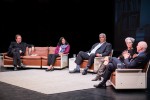The “10 Questions” lecture series, which will address a different question each week, doubles as a course for students and a panel open to the public. The series will explore open-ended questions such as “What is beauty?”, “What is failure?” and “What is knowledge?”
Each week’s panel will feature two faculty members from the School of the Arts and Architecture and two faculty members from other departments who will approach the question of the week from the perspective of their academic disciplines.
A UCLA professor showcased a photograph she took of fog to illustrate infinity from an artistic point of view.
Rebeca Méndez, a design media arts professor, was one of the four speakers at the “10 Questions” panel Tuesday that aimed to answer the question “What is time?”
Méndez said she uses art to make herself fully realize that she is living in the moment. She said she used a 16 mm camera to capture the images she showcased at the panel.
“For me, time is me,” Méndez said. “I create work that makes me feel like I am at the very instant at the present.”
James Newton, a distinguished professor of ethnomusicology, said he also views time from an artistic standpoint. Newton, a composer and flutist, shared his arrangement of “Amazing Grace,” which he dedicated to the victims of the 2015 church shooting in Charleston, South Carolina. Newton said certain beats in his arrangement make it feel like time passes by more slowly.
“(It) tries to show time is still,” Newton said. “Even though (it) has a pulse, it has the feeling that it’s out of time.”
The two other speakers approached time from a historical perspective. Asma Sayeed, an associate professor of Islamic studies, talked about the concept of time in relation to early Islamic society. Sayeed showed an image of a clock built in the 12th century and said the complexities in its design and technology represented advances in science and technology during the time period.
“(It was) not a mechanical device meant to tell time,” Sayeed said. “It was a celebration of culture, technological advancement, that incorporated artistic influences.”
Sayeed said the concept of time in Islamic society incorporates various fields’ interpretations of time, including the sciences, arts and humanities.
“There is no monolithic concept of time in Islam,” Sayeed said. “Time is a canvas for Muslims, contemplated and explored (through) the sciences, arts and humanities.”
Scott Waugh, a medieval historian and UCLA’s executive vice chancellor and provost, described how the understanding of time has changed through history. Waugh said before human civilization used formal measures of time, time would be marked by celebrations and tasks.
“Calendar was dominated by rhythms of agriculture,” Waugh said. “The sun, cock crow, sunset, sunrise (set) the rhythms of life.”
Speakers also engaged in a question-and-answer session with the audience and discussed one another’s presentations.
Jared White, a member of the public who attended the event, said he enjoyed learning about the topic from different angles, especially about how the view of time evolved through history.
“I’ve never heard of how they viewed time where they would have trials and debates over how old someone was,” White said. “Time is now an objective factual reality when it used to be a matter of debate.”
Sayeed said she thinks the event gives students the chance to think about time from a unique standpoint.
“For college students, time is oppressive and controlling,” Sayeed said. “(This event) allows you to step outside that and think about people from different places and cultures.”
